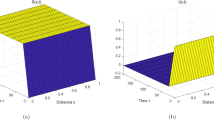Abstract
In this paper, we study a diffusive HCV infections epidemic model with nonlinear incidence rate and analyze the stability of the two kinds of equilibria. By constructing various Lyapunov functions, we prove that the disease-free equilibrium is globally asymptotically stable when the basic reproduction number \(R_{0}< 1\) and the endemic equilibrium is globally asymptotically stable when the basic reproduction number \(R_{0} >1\). Finally, some numerical simulations are given to confirm the theoretical analysis. The results show that when other parameters are the same, the linear infection rate and the non-linear infection rate have different effects on disease spread.


Similar content being viewed by others
References
Chen, S.L., Morgan, T.R.: The natural history of hepatitis C virus (HCV) infection. Int. J. Med. Sci. 3(2), 47–52 (2006)
Lavanchy, D.: The global burden of hepatitis C, Liver international?: official. J. Int. Assoc. Stud. Liver 29(s1), 74–81 (2009)
Kermack, W.O., McKendrick, A.G.: A contribution to the mathematical theory of epidemics. Proc. R. Soc. London Ser. A Contain. Pap. Math. Phys. Character 115, 700–721 (1927)
Slama, H., Hussein, A., El-Bedwhey, N.A., Selim, M.M.: An approximate probabilistic solution of a random SIR-type epidemiological model using RVT technique. Appl. Math. Comput. 361, 144–156 (2019)
Yang, J., Wang, X.: Dynamics and asymptotical profiles of an age-structured viral infection model with spatial diffusion. Appl. Math. Comput. 360, 236–254 (2019)
Long, Y., Wang, L.: Global dynamics of a delayed two-patch discrete SIR disease model. Commun. Nonlinear Sci. 83, 105117 (2020)
Ramos, A.B.M., Schimit, P.H.T.: Disease spreading on populations structured by groups. Appl. Math. Comput. 353, 265–273 (2019)
Zhang, F., Zhao, T., Liu, H., Chen, Y.: Backward bifurcation in a stage-structured epidemic model. Appl. Math. Lett. 89, 85–90 (2019)
Yang, J., Jin, Z., Xu, F.: Threshold dynamics of an age-space structured SIR model on heterogeneous environment. Appl. Math. Lett. 96, 69–74 (2019)
Zhang, W.: Analysis of an in-host tuberculosis model for disease control. Appl. Math. Lett. 99, 105983 (2020)
Cui, R., Lou, Y.: A spatial SIS model in advective heterogeneous environments. J. Diff. Eq. 261, 3305–3343 (2016)
Bentaleb, D., Amine, S.: Lyapunov function and global stability for a two-strain SEIR model with bilinear and non-monotone incidence. Int. J. Biomath. 12(2), 1950021 (2019)
Okuonghae, D.: Lyapunov functions and global properties of some tuberculosis models. J. Appl. Math. Comput. 48, 421–439 (2015)
Yang, J., Xu, F.: Global stability of two SIS epidemic mean-field models on complex networks: Lyapunov functional approach. J. Franklin Instit. 355, 6763–6779 (2018)
Andrei, M.A.V.K.: Lyapunov functions and global stability for SIR and SEIR models with age-dependent susceptibility. Math. Biosci. Eng. 10, 369–78 (2013)
Perelson, A.S., Guedj, J.: Modelling hepatitis C therapy-predicting effects of treatment. Nature Rev. Gastroenterol Hepatol. 12(8), 437–45 (2015)
Martcheva, M., Castillo-Chavez, C.: Diseases with chronic stage in a population with varying size. Math. Biosci. 182(1), 1–25 (2003)
Yuan, J., Yang, Z.: Global dynamics of an SEI model with acute and chronic stages. J. Comput. Appl. Math. 213(2), 465–476 (2007)
World Health Organization, Hepatitis C (2019). www.who.int/news-room/fact-sheets/detail/hepatitis-c
Cui, J., Zhao, S., Guo, S., Bai, Y., Wang, X., Chen, T.: Global dynamics of an epidemiological model with acute and chronic HCV infections. Appl. Math. Lett. 103, 106203 (2020)
Derrick, W., van den Driessche, P.: A disease transmission model in a nonconstant population. J. Math. Biol. 31, 495–512 (1993)
Lizana, M., Rivero, J.: Multiparametric bifurcations for a model in epidemiology. J. Math. Biol. 35, 21–36 (1996)
Liu, J., Peng, B., Zhang, T.: Effect of discretization on dynamical behavior of SEIR and SIR models with nonlinear incidence. Appl. Math. Lett. 39, 60–66 (2015)
Ma, L., Luo, Y., Li, S.: Bifurcation analysis of a two-species diffusive model. Appl. Math. Lett. 96, 236–242 (2019)
Chen, X., Cui, R.: Global stability in a diffusive cholera epidemic model with nonlinear incidence. Appl. Math. Lett. 111, 106596 (2021)
Duan, L., Xu, Z.: A note on the dynamics analysis of a diffusive cholera epidemic model with nonlinear incidence rate. Appl. Math. Lett. 106, 106356 (2020)
Cai, Y., Wang, K., Wang, W.: Global transmission dynamics of a Zika virus model. Appl. Math. Lett. 92, 190–195 (2019)
Han, S., Lei, C.: Global stability of equilibria of a diffusive SEIR epidemic model with nonlinear incidence. Appl. Math. Lett. 98, 114–120 (2019)
Gao, X., Ishag, S., Fu, S., Li, W., Wang, W.: Bifurcation and Turing pattern formation in a diffusive ratio-dependent predator-prey model with predator harvesting. Nonlinear Anal-Real. 51, 102962 (2020)
Du, Z., Peng, R.: A priori \(L^{\infty }\) estimates for solutions of a class of reaction-diffusion systems. J. Math. Biol. 72, 1429–39 (2016)
Wang, Y., Cao, J.: Global dynamics of a network epidemic model for waterborne diseases spread. Appl. Math. Comput. 237, 474–488 (2014)
Cao, J., Wang, Y., Alofi, A., Al-Mazrooei, A., Elaiw, A.: Global stability of an epidemic model with carrier state in heterogeneous networks. Ima J. Appl. Math. 80(4), 1025–1048 (2015)
Acknowledgements
This work is supported by the Natural Science Foundation of China (11672074), and the Natural Science Foundation of Fujian Province (2018J01655).
Author information
Authors and Affiliations
Corresponding author
Additional information
Publisher's Note
Springer Nature remains neutral with regard to jurisdictional claims in published maps and institutional affiliations.
Rights and permissions
About this article
Cite this article
Su, R., Yang, W. Global stability of a diffusive HCV infections epidemic model with nonlinear incidence. J. Appl. Math. Comput. 68, 2685–2697 (2022). https://doi.org/10.1007/s12190-021-01637-3
Received:
Revised:
Accepted:
Published:
Issue Date:
DOI: https://doi.org/10.1007/s12190-021-01637-3



